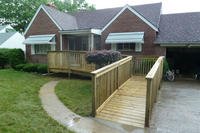The VA home loan program has been around for seven decades. This long-cherished benefit has backed more than 24 million military mortgages since 1944.
But in many ways, it’s more important today than ever before.
Many lenders tightened their lending requirements after the housing market collapse. Access to credit is starting to loosen, but it’s still tough for many service members and veterans to secure a conventional mortgage.
That’s a big reason why the historic VA loan program is experiencing a resurgence. VA purchase loans have increased eight years in a row, with younger veterans and service members leading the way.
To be sure, VA loans aren’t automatically the best fit for every veteran. But they feature significant benefits that can make homeownership possible for those who might otherwise struggle to secure financing.
Here’s a look at four reasons VA loans are so powerful in today’s housing market.
1. Zero down payment
Being able to purchase a home without making a down payment is a tremendous benefit for military borrowers.
Many homebuyers must spend years saving enough money to cover the usual minimum down payment for conventional (5 percent) or Federal Housing Administration (FHA) loans (3.5 percent). On a $300,000 purchase, you’re talking about a nest egg of $15,000 for conventional and $10,500 for FHA.
VA borrowers don’t need to come to the closing table with that kind of cash. That allows veterans and service members to get into homes sooner.
2. No mortgage insurance
On top of that, all FHA borrowers and conventional buyers who can’t put down 20 percent are required to pay for mortgage insurance. That can add a couple of hundred dollars to your monthly mortgage payment.
Conventional borrowers can often get out from under their mortgage insurance once they’ve built up about 20 percent equity in the home. But FHA borrowers now pay their mortgage insurance for the duration of their mortgage term, which is often 30 years.
Despite the $0 down payment, VA loans don’t come with or require mortgage insurance. That’s a huge benefit that helps veterans stretch their buying power.
3. Flexible requirements
VA borrowers don’t need a sky-high credit score to secure a mortgage. Lenders are generally looking for a credit score of about 620, which is considerably lower than what you’ll typically need for conventional financing.
VA lenders can also have flexible benchmarks when it comes to your debt-to-income (DTI) ratio, which looks at the relationship between your monthly income and major expenses. While the VA wants to see a DTI ratio of 41 percent or less, some lenders may allow a higher percentage for otherwise qualified borrowers.
VA borrowers can typically look to secure a new mortgage just two years removed from a foreclosure, short sale or bankruptcy.
4. Rates and closing costs
Contrary to common misconception, interest rates on VA loans are competitive with conventional mortgage rates, if not consistently lower. That’s another potential cost-savings benefit for VA homebuyers. Lower rates can mean lower monthly payments.
The VA also limits what veterans pay in closing costs. In fact, VA borrowers are flat-out barred from paying some costs. Sellers can pay all of a buyer’s mortgage-related closing costs and up to 4 percent of the purchase price in concessions, which can cover things like prepaid property taxes and homeowners insurance.
There’s no guarantee a seller will pay some, all or any of your closing costs. But these protections and benefits help put VA borrowers in a great position to get the most from this increasingly powerful loan option.
Take the Next Step
If you're ready to move forward, or just want more information, the first step is to get no-obligation rate quotes.




